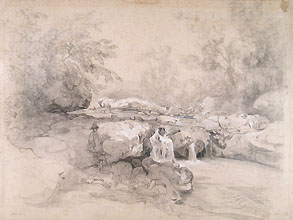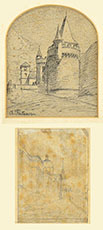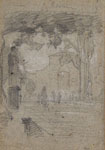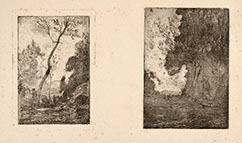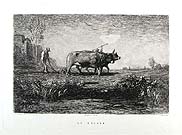(Reggio Emilia 1818 - Turin 1882)
YOUNG GIRL STANDING NEAR A STREAM, c. 1865
Watercolour over traces in pencil. Signed at bottom left A. Fontanesi. 220 x 150 mm.
The figure of the girl in our watercolour is the same who appears in the etching by Fontanesi called Le pastore or Presso il rivo (Dragone 71)
It is interesting to note that the cardboard on the back of the original frame of the drawing bears in pen the date May 1865, when Fontanesi lived in London.
Fontanesi studied at the Scuola di Belle Arti in Reggio Emilia. Between 1841 and 1846 he made the sets for the city theatre and began painting landscapes. In 1850 he moved to Geneva, working within the sphere of Alexandre Calame, Corot and Daubigny. Here he set up a studio and displayed his work at the main exhibitions. His main area of interest was landscape painting, which he expanded on after visiting the Universal Exhibition in Paris in 1855. This trip marked the beginning of a period characterized by important exhibitions and by prestigious appointments, such as his nomination as director and professor of illustration at the Academy of Lucca, but above all his chair as a landscape professor in Turin.
In 1876, the Technical Fine Arts School, an art school of painting and sculpture, was founded in Tokyo. It was the first governmental art school founded in Japan. The Meiji government contracted three Italian artists as foreign advisors: Vincenzo Ragusa for sculpture, Antonio Fontanesi for drawing and Giovanni Cappelletti for the preparatory course. The trio greatly influenced the development of Japanese art through the next several decades. Fontanesi introduced the techniques of charcoal, crayon and oil paints to his Japanese students. He also taught western concepts of perspective, anatomy and sketching from life. His career in Japan was cut short by serious illness, which forced him to return to Italy in 1878.

